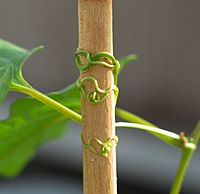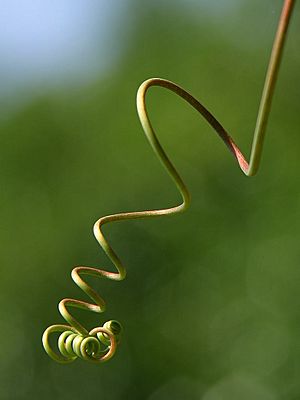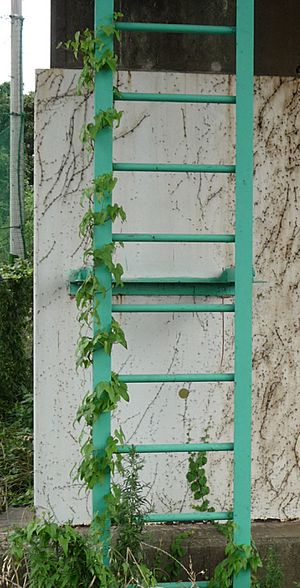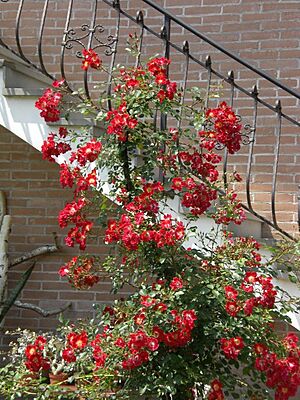Climbing plant facts for kids
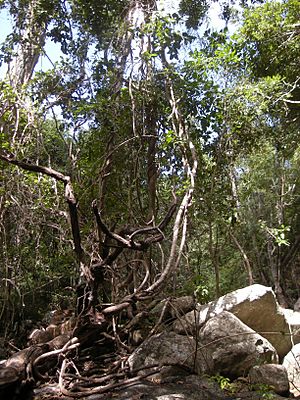
Climbing plants are amazing plants. They grow upwards on trees and other tall things. Many are called vines. Their stems twist around branches and supports. But plants can climb in many other ways too!
Plants have developed the ability to climb many times. This climbing "habit" helped them succeed. Climbing plants often have more different types (species) than their relatives that don't climb. It's like a super power that has worked really well. More than 130 plant families include climbers. In tropical forests, vines can make up over 40% of all plant types!
Climbing has developed on its own in different plant families. They use many different ways to climb. Scientists usually put climbing plants into two main groups:
Contents
Bines: Twisting Stems
Bines are plants that climb by twisting their stems around a support. Many bines have rough stems. Some even have bristles pointing downwards. These help them get a better grip.
- Hops are a good example. They are used to flavor beer.
- Morning glory plants, like Ipomoea species, are bines.
- Honeysuckle is another common bine.
Vines: Using Special Tools
Vines use special parts to climb. These can be tendrils, suckers, or other clever tools.
- Some vines use their leaf stalks (called petioles) to twine, like Clematis species.
- Others use tendrils. These tendrils can be special shoots (like in Vitaceae plants). They can also be modified leaves (like in Bignoniaceae). Or they can even be part of the flower cluster (like in Passiflora).
- Some tendrils have sticky pads at their ends. These pads attach very strongly to a support. An example is Parthenocissus, also known as Virginia creeper.
- Some plants use thorns or other hooked parts to climb. Climbing roses use thorns. Artabotrys hexapetalus uses hooked branches.
- Some climb using special roots that cling to surfaces. Common ivy (Hedera species) does this.
The Strange Climbing Fetterbush
The climbing fetterbush (Pieris phillyreifolia) is a very unusual climber. It's a woody shrub that climbs without roots, tendrils, or thorns. Its stem finds a crack in the bark of trees with stringy bark. An example is the bald cypress. The fetterbush stem then flattens out. It grows up the tree underneath the host tree's outer bark! Later, the fetterbush sends out branches. These branches pop out near the top of the host tree.
Most vines are flowering plants. These can be divided into two types:
- Woody vines or lianas: These have strong, woody stems. Examples include wisteria, kiwifruit, and common ivy.
- Herbaceous vines: These have soft, non-woody stems. Morning glory is an example of a herbaceous vine.
Climbing Ferns
One unique group of climbing plants is the fern genus Lygodium. These are called "climbing ferns." It's not their stem that climbs. Instead, their fronds (which are their leaves) do the climbing! The fronds unroll from their tips. They can theoretically grow forever. As they unroll, they can form thick mats over other plants, rocks, and fences.
Examples of Climbing Plants
- Bougainvillea
- Calabash
- Campsis
- Chayote
- Clematis
- Common ivy
- Cucumber
- Cyclamen
- Grape
- Honeysuckle
- Hydrangea
- Kudzu
- Luffa
- Lygodium
- Morning glory
- Nepenthes
- Passionfruit
- Poison ivy
- Solanum
- Sweet pea
- Virginia creeper
- Vitis
- Wild grape
- Wisteria
Images for kids
-
Betel, a climbing plant
-
Ficus pumila's vigorous wall growth
-
Bower vine's showy flowers



